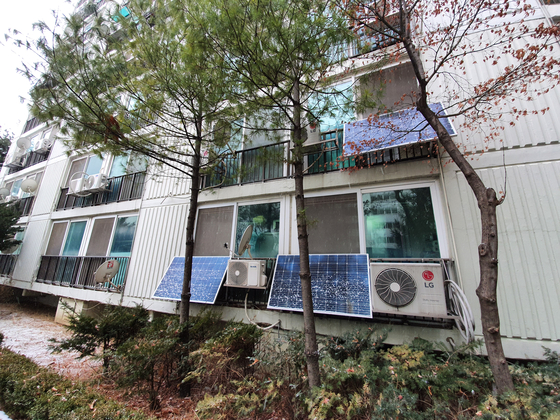![Solar panels installed in a rental house in Seoul are hidden in the shade of trees. [사진 이성배 의원실]](https://i0.wp.com/pds.joins.com/news/component/htmlphoto_mmdata/202103/04/aaacf079-7906-404c-b312-fb0c1e97ccc9.jpg?w=560&ssl=1)
Solar panels installed in a rental house in Seoul are hidden in the shade of trees. [사진 이성배 의원실]
It has been argued that the electricity bill reduction effect of the photovoltaic mini-power plant installed by the Seoul Housing and Urban Corporation (SH Corporation) in rental housing is only about a fifth of the construction estimate. It is analyzed that this is because the solar panel is installed in a shaded place, which reduces the efficiency. Accordingly, SH Corporation announced that it would prepare installation guidelines.
“Only solar panel installation companies are satisfied”
SH Corporation “Preparation of installation guidelines”
According to data submitted by SH Corporation by Seoul Metropolitan Council member Lee Seong-bae, a member of the People’s Power on the 4th, SH Corporation installed 43,326 solar power plants in a total of 316 rental housing complexes from 2015 to 2020. The solar mini-power plant is a small power plant of less than 50W~1kW and is mainly installed on the veranda of an apartment.
The installation cost per mini power plant is 489,000 won. SH Corporation provides 99,000 won in personal contribution, so residents of rental housing do not have to pay any money. The budget that SH Corporation has spent on installing a mini power plant over the past six years is about 23.1 billion won.
At an extraordinary meeting of the Seoul City Council held on the 3rd, Lee said to SH Corporation President Se-Yong Kim, “The solar mini-power plant has invested a lot of budget, but it does not produce that much effect.” As a basis for this, Congressman Lee cited rental housing in Gayang-dong and Banghwa-dong, Gangseo-gu. It is claimed that the mini power plant was installed on the first and second floors of the apartment, covered by trees, and was installed on the lower floors facing the south, and found a number of shaded panels.
![Lee Seong-bae, a member of the Seoul City Council, explained that when the PWI (instantaneous power generation) is 13W (watt), considering that the maximum solar power generation time per day is 3.2 hours, it means that 41.6Wh of electricity is produced per day. [사진 이성배 의원실]](https://i0.wp.com/pds.joins.com/news/component/htmlphoto_mmdata/202103/04/2ea9c502-336a-402d-9707-590ebada2160.jpg?w=560&ssl=1)
Lee Seong-bae, a member of the Seoul City Council, explained that when the PWI (instantaneous power generation) is 13W (watt), considering that the maximum solar power generation time per day is 3.2 hours, it means that 41.6Wh of electricity is produced per day. [사진 이성배 의원실]
He said, “As a result of checking the power output by visiting Gagaho, the instantaneous power generation was 4W (watt), 13W, etc. Considering that the maximum solar power generation time per day is 3.2 hours, 12.8Wh (watt-hour) and 41.6Wh per day are produced. This is far less than the 300W per hour power generation announced by SH Corporation.”
“The residents couldn’t even explain properly and installed the panel”
Congressman Lee said, “It was cloudy, but when I looked around 10 places, I couldn’t find a place with an instantaneous power output of more than 100W even in broad daylight. ”Insisted.
According to SH Corporation, installing a mini power plant can reduce electricity bills of 5,000 won per household per month and 60,000 won per year based on 300W per hour power generation. The amount that can be saved for all households with mini-power plants installed is about 2.83 billion won.
![Lee Seong-bae, a member of the Seoul City Council. [이성배 의원실]](https://i0.wp.com/pds.joins.com/news/component/htmlphoto_mmdata/202103/04/bea83066-481f-426e-a4a3-3e7a25ba3f49.jpg?w=560&ssl=1)
Lee Seong-bae, a member of the Seoul City Council. [이성배 의원실]
Congressman Lee said, “When I asked the residents about the effect of installing solar power, most of them answered that they did not feel the savings, or even if they felt it, it was about 1,000 to 2,000 won per month. “It has to be over 20 years old to be as effective as the cost.” He added that the period will be longer when considering the cost of removing and repairing solar panels in the future.
In addition, Congressman Lee said, “Solar panels should be installed in places where there is abundant sunlight or where electricity bills exceed 100,000 won,” and said, “Only panel installers have benefited from the reckless solar mini-power plant business.” Insisted. In general apartments, when the solar panel is installed, the landlord has to pay 90,000 to 240,000 won, so it is possible to determine whether or not to make a profit. In fact, some residents complained that the panel covered the window and complained of the inconvenience.

SH Seoul Housing and Urban Corporation President Kim Se-yong announced a public housing project promotion plan for improving the residential environment of Yeongdeungpo village and urban improvement at the conference room of Yeongdeungpo Station in Seoul last year. News 1
“We need to consider the amount of sunlight and install solar panels,” said Se-Yong Kim, president of SH Corporation, saying, “We have to set up a housing plan under the premise of installing solar power, but we overlooked that part.” I will do it.”
Reporter Choi Eun-kyung [email protected]
![]()
